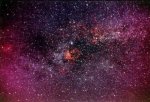Red and Orange Fills September's Night Sky
Journey to Red and Orange stars in September's night sky
Fall is in full bloom in the Northern Hemispheres of planet Earth and lovers of the reds, oranges, and bright reds on the leaves of fall will enjoy the rich, warm and colourful hues in the night sky of September and October.
If you're heading out into the wild to enjoy Mother Nature's bounty at this time of year? After the day walking through the forest watching the leaves on the trees turn color, from drab green to mixed shades of yellow, orange, and red. Take the time to lay back on the cold ground or your sleeping bag and check out the colors in the night sky. Even better, set up your binoculars or time machine to the stars, and enjoy the colors in the night sky by taking a journey to the beginning of the universe.
Star gazers have witnessed the colorful displays in the night sky for generations and our ancestors surely spent many a night staring upwards in wonder at the various colors they could see in the night sky. It was 19th-century Irish astronomer John Birmingham, who first made note of the colorful hues of light in the night sky. His ideas and the thoughts of Danish astronomer Hans Schjellerup, who had compiled a catalogue of red stars in 1866, were mentioned in Birmingham's work "The Red Stars: Observations and Catalogue". This catalogue contains a total of 658 red and orange stars colorful enough to delight the human senses and make your imagination dance a lively step.
Reading the introduction of Birmingham's catalogue of red and orange stars, one notes he mentions a region of space and time he refers to as "The Red Region". This region includes parts of the Milky Way Galaxy, between Aquila, Lyra, and Cygnus, that are filled with orange and red stars that will make the eyes dance and entice the human imagination to create possibilities beyond anything we as humans have imagined.
September is the perfect time for you to board your time machine to the stars and journey to the beginning of the universe to experience the Red Region. The Red Region will be well above the southern horizon, once the sun goes down. This region of space and time has eye-gems for star gazers to view in September, with reds and oranges that will make lovers of fall smile, and turn up their color sensitivity. The colorful stars in the Red Region warm sequentially through spectral classes: G (yellow), K (orange), M (red) and rare carbon class C (deep red). Astronomers have subdivided star classes from 0 to 9, with a G9 star being a little closer to orange, than yellow, and a K5 star having a color somewhere between orange and red.
All star gazers will see varying hues of red, orange, and yellow during their journey to the beginning of the universe that will depend on each star gazers own particular biology. In fact, we all view color slightly differently, so individual star gazers shouldn't rely on a star's spectral class for a visual clue to a star's true color. Take for example, the strikingly colorful, double star Albireo (Beta Cygni) in Cygnus. Star gazers through the centuries have described its magnitude 3.1 K3 primary star as yellow, topaz, gold and orange. Its magnitude 5.1 B9 (blue-white) secondary star (34" away) on the other hand, has been described as deep-blue, azure, sapphire and even green.
The perception of color for humans is subjective and depends on varying individual parameters that can also be a product of physiological and psychological effects, such as the strong contrasting colors of a double star, like Albireo. The colors star gazers view through their time machine to the stars can also be obscured by dust and pollutants in the air, which will redden a stars color. Stars that are low on the horizon, in comparison to higher stars, will also appear redder to viewers, just like the sun turns redder as it falls toward the horizon.
In : the night sky
